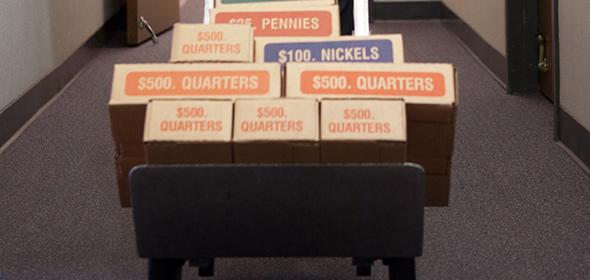
“Methodically” is the best way for businesses to prepare for a cash pick-up by an armored truck. What follows can be turned into a checklist for cash handlers who are assembling cash (and checks) for a bank deposit via secure armored transport.
To help speed up the process of authenticating and documenting the various elements of a large bank deposit, business owners should invest in an ink stamp that has the following information:
• [Company name] – This should be Identical to the name on the receiving bank account (such as an LLC or corporation name) and also include the “dba” or business name, if different, as it’s known to customers and employees.
• [Location and phone number] – This should have the street address, city and phone number. State and zip code aren’t necessary identifiers.
• These following exact words should be ink-stamped when the stamp is used, each with a short line after it, so cash handlers know to fill it out:
Deposit Date: ________________
Amount: ____________________
Preparer’s initials: ____________
For currency deposits: Stack all currency face-up, sort it by denomination, and bundle 100 notes of each denomination using the appropriate color-paper strap:
• Ones (Blue Strap) $100
• Fives (Red Strap) $500
• Tens (Yellow Strap) $1,000
• Twenties (Purple Strap) $2,000
• Fifties (Brown Strap) $5,000
• Hundreds (Gold Strap) $10,000
For less than 100 notes of any currency, reverse the strap with its colored and printed side down, wrap it around the currency and write the amount on the strap. If you’re combining currencies, sort them from the smallest to the largest bills, then wrap and notate them similarly.
Cash handlers should then stamp all the wrapped currency and include the date, amount and their initials. Then they should bale the bundles together in ascending order of denominations, placing any partial bundle(s) of mixed denominations on top.
For coin deposits: Large amounts of loose, multi-denominational coins should be put in disposable plastic coin bags, each weighing no more than 50 pounds when full. Smaller amounts of coins should be put in an envelope. Both types of packages should be stamped, dated, total amount indicated, and initialed.
For check deposits: Checks, like currency, should be stacked face up and wrapped with the calculator tape used to total them. They should also be stacked in the same order as they appear in calculator tape. If calculated by hand, the checks should be listed in the order they appear in their stack.
Deposit tickets: Some companies require one deposit ticket for cash and coin, and another for checks. Either way, carbon duplicate deposit tickets should be used, so one can be included in the depository bag while the duplicate is kept for a record of the deposit. Tickets should be pre-printed (and pre-numbered) with the same business name that’s on the receiving bank account, the “dba” name, the business address and phone number, and the account number. Each ticket should be clearly completed, totaled, the total double-checked for accuracy, and include the preparer’s initials and day’s date.
Preparing for pick-up: It’s best to use dual-pouch, tamper-resistant depository bags that can be obtained from your bank or bought separately. Outside each bag should be space for putting the business name, deposit date, account number, business location, total cash, total checks and total of both.
If you use multiple bags, mark them clearly with their number, using the convention #1 of 3, #2 of 3, and #3 of 3, so the cash messenger can easily know how many total bags there are and quickly account for them.
Bags should then be sealed and the deposit ticket copy should be affixed to a log of the cash pick-up that includes the date, time, name of the cash messenger, the number from their Authorized Agent Card (if a Garda cash messenger), and the messenger’s signature.
To find out more, visit https://www.garda.com/cash-services.








